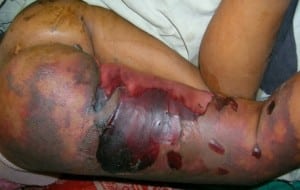| Author | Affiliation |
|---|---|
| Sudip Kumar Ghosh, MD, DNB, D.DERMAT | R.G. Kar Medical College, Kolkata, India, Department of Dermatology, Venereology, and Leprosy |
| Debabrata Bandyopadhyay, MD | R.G. Kar Medical College, Kolkata, India, Department of Dermatology, Venereology, and Leprosy |
| Abhijit Dutta, MD | R.G. Kar Medical College, Kolkata, India, Department of Pediatric Medicine |
A previously healthy 14-year-old girl presented to the emergency department with high fever, cough, shortness of breath and right lobar pneumonia on chest radiograph. She had extensive purpura with hemorrhagic bullae on her left leg. The patient was very ill-appearing with hypotension, tachycardia, tachypnea, and oliguria. There was no other bleeding. Hemogram showed leukocytosis (13000/cmm) with 35% bands, platelets 76,000/ml and sedimentation rate of 98 mm. The prothrombin time and partial thromboplastin time were prolonged and the fibrin degradation products were grossly elevated. Blood culture grew group-A streptococci. A diagnosis of purpura fulminans from septic shock was made. She was resuscitated and given parenteral antibiotics and platelets. The patient recovered within two weeks and later had skin grafting.
Purpura fulminans is an infrequent, often fatal, acute cutaneous reaction resulting from infective or non-infective conditions.1 When it arises during sepsis, in-hospital mortality is 42%.2 Antecedent infections are most commonly group-A streptococcus, staphylococcus, peumococcus, vibrio, and meningococcus, and less commonly varicella.3Neonates with protein C and protein S deficiencies are at higher risk for purpura fulminans. Patients with systemic lupus erythematosis may have antiphospholipid antibody syndrome.1 The disease may occur without preceding illness.1
Purpura fulminans from sepsis requires surgical debridement, skin grafting and even amputation.4 Normal saline resuscitation restores volume and promotes urine output >0.5ml/kg/hour.5 Although there is no proven benefit, treatment of severe disseminated intravascular coagulation with purpura fulminans with heparin may be warranted.5,6Most clinicians prefer to provide platelet replacement if platelet counts drop below 20,000/mL.5,6 Administration of protein C concentrate early in the course of the disease may reduce both morbidity and mortality.3 There is some evidence that recombinant tissue plasminogen activator infusion may result in improved organ perfusion and cardiac performance.7

Footnotes
Supervising Section Editor: Christopher Kang, MD
Submission history: Submitted July 04, 2008; Revision Received October 24, 2008; Accepted October 24, 2008
Full text available through open access at http://escholarship.org/uc/uciem_westjem
Address for Correspondence: Dr. Sudip Kumar Ghosh Vill + P.O Rajballavpur(Via-Maslandpur) Dist 24 parganas(N), West Bengal, PIN 743289, India
E-mail: dr_skghosh@yahoo.co.in
Conflicts of Interest: By the WestJEM article submission agreement, all authors are required to disclose all affiliations, funding sources, and financial or management relationships that could be perceived as potential sources of bias. The authors disclosed none.
REFERENCES
1. James WD, Berger TG, Elston DM. Cutaneous vascular diseases. In: James WD, Berger TG, Elston DM, editors. Andrew’s diseases of the skin: clinical dermatology. 10th ed. Philadelphia, Pa: Saunders; 2006.
2. Rintala E, Kauppila M. Protein C substitution in sepsis-associated purpura fulminans.Critical Care Med. 2000;28:2373–2378. [PubMed]
3. Paller AS, Goldsmith LA, Pyodermas . Staphylococcus aureus, streptococcus, and other gram positive bacteria. In: Freedberg IM, Eisen AZ, Wolff K, Austen KF, Goldsmith LA, Katz SI, editors. Fitzpatrick’s dermatology in general medicine. 6th ed. New York, NY: McGraw-Hill; 2003. pp. 1856–1878.
4. Wheeler JS, Anderson BJ, De Chalain TM. Plastic surgical interventions in children with meningococcal purpura fulminans–a review of 117 procedures in 21 children. J Pediatr Surgery. 2003;38:597–603.
5. Munford RS. Severe sepsis and septic shock. In: Kasper DL, Braunwald E, Fauci AS, Hauser SL, Longo DL, Jameson JL, editors. Harrison’s principles of internal medicine. 16th ed. New York, NY: McGraw-Hill; 2005. pp. 1606–1612.
6. Toh CH, Dennis M. Disseminated intravascular coagulation: old disease, new hope. BMJ.2003;327:974–977. [PMC free article] [PubMed]
7. Aiuto LT, Barone SR, Cohen PS, Boxer R. A2 Recombinant tissue plasminogen activator restores perfusion in meningococcal purpura fulminans. Crit Care Med. 1997;25:1079–1082. [PubMed]


